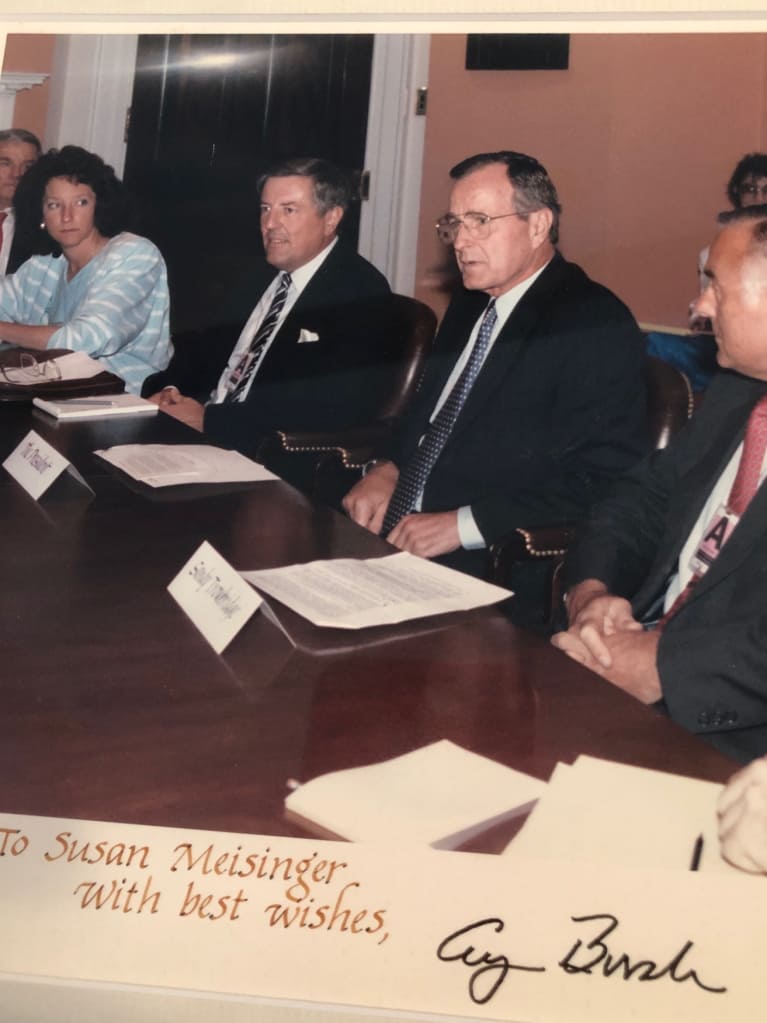President Bush's Support Helped Make Americans with Disabilities Act a Reality
President George H.W. Bush secured bipartisan support for ADA's enactment

Through President George H.W. Bush's bipartisan leadership, the Americans with Disabilities Act (ADA) was enacted, and the workplace hasn't been the same.
Following Bush's death on Nov. 30, President Donald Trump announced that Dec. 5 would be a National Day of Mourning. It is a day to honor the humanity and accomplishments of this former president, and one of his most lasting achievements was the enactment of the ADA.
Early in Bush's administration, he signaled that the ADA "would happen under his watch," recalled Bobby Silverstein, an attorney with Powers Pyles Sutter & Verville PC in Washington, D.C., who is credited with being the behind-the-scenes drafter and negotiator of the ADA. Silverstein was staff director for the ADA's lead Senate sponsor, then Sen. Tom Harkin, D-Iowa, and chief counsel for the Senate Subcommittee on Disability Policy when the legislation was drafted.
How businesses operated before and after the ADA was like night and day, Silverstein said. Before the law was enacted, the first question employers asked applicants was whether they had a disability. If the applicants did, they were shown the door.
Under Bush's leadership, both sides of the congressional aisle played a role to pass the ADA and right that wrong. Harkin and then Sen. Ted Kennedy, D-Mass., were key proponents of the legislation, as were Sens. Bob Dole, R-Kan.; David Durenberger, R-Minn.; and Orrin Hatch, R-Utah.
 So was the Society for Human Resource Management (SHRM). "SHRM played a leadership role in the coalition that worked to ensure that the ADA, which we supported, would be capable of practical administration," said former SHRM President and CEO Susan Meisinger, SHRM-SCP. "The Bush administration, and the president, were committed to enacting legislation to support people with disabilities in both employment and access to public accommodations, without placing unnecessary regulatory burdens on business and local communities. SHRM led the business community in working with the president to make that happen."
So was the Society for Human Resource Management (SHRM). "SHRM played a leadership role in the coalition that worked to ensure that the ADA, which we supported, would be capable of practical administration," said former SHRM President and CEO Susan Meisinger, SHRM-SCP. "The Bush administration, and the president, were committed to enacting legislation to support people with disabilities in both employment and access to public accommodations, without placing unnecessary regulatory burdens on business and local communities. SHRM led the business community in working with the president to make that happen."
'Inspiring Coalition'
Disability rights leader Justin Dart Jr. and then Equal Employment Opportunity Commission Chairman Evan Kemp Jr., both wheelchair users, were friends of Bush and "whispered in his ear" in favor of the ADA, Silverstein said. Bush personally thanked them when he signed the legislation into law on July 26, 1990.
The law bans pre-employment medical inquiries and questions about disability until the employer makes a job offer, prohibits disability discrimination and requires employers to reasonably accommodate individuals with disabilities.
"It's been the work of a true coalition, a strong and inspiring coalition of people who have shared both a dream and a passionate determination to make that dream come true," Bush said at the signing. "It's been a coalition in the finest spirit—a joining of Democrats and Republicans, of the legislative and the executive branches, of federal and state agencies, of public officials and private citizens, of people with disabilities and without."
In the House of Representatives, the ADA was led by Rep. Tony Coelho, D-Calif., and subsequently Rep. Steny Hoyer, D-Md., after Coelho resigned.
The law prohibits private employers with 15 or more employees from discriminating based on disability and bars state and local governments from disability discrimination, as well as private entities open to the public.
The ADA has resulted in a "higher recognition that reasonable accommodations are not expensive," Silverstein said. Employers generally understand there is "no place for discrimination when trying to get the most-qualified people." Most employers realize that the ADA recognizes legitimate business concerns by providing that reasonable accommodations aren't required when they'd result in an undue hardship or a direct threat to the health and safety of the employee or others, he added.
[SHRM members-only toolkit: Accommodating Employees' Disabilities]
Getting Creative
"More than anything, the ADA has expanded the way that people view individuals with disabilities, and expanded the way people view who might be included within that universe of people with disabilities," said Michael McClory, an attorney with Bullard Law in Portland, Ore.
Before the ADA, the Rehabilitation Act of 1973 prohibited the federal government, federal contractors and federal fund recipients from discriminating based on disability. The ADA broadened protections from disability discrimination to many more people.
"Gradually, employers have become more creative in the way that they envision how certain things can be accomplished" because of the law's reasonable accommodation requirement, he observed. This has "helped employers become more creative overall."
Unfinished Business
Silverstein noted that there is more work to be done.
There "still are employers who use stereotypes to deny opportunities," he observed. On the other hand, he said no one writing the law expected that there would be no discrimination after it was enacted.
The next generation of lawsuits is over whether public accommodations' websites are accessible, said Scott Topolski, an attorney with Cole Schotz in Boca Raton, Fla. Some courts are holding that websites must be linked to a brick-and-mortar business in order to require their accessibility to blind and visually impaired individuals, as well as other persons with disabilities. But other courts are letting cases go forward against public accommodations even if the businesses are only online, he noted.
In addition to these lawsuits, job applicants are suing over inaccessible careers websites under a California law similar to the ADA.
[Visit SHRM's Americans with Disabilities Act resource page.]



